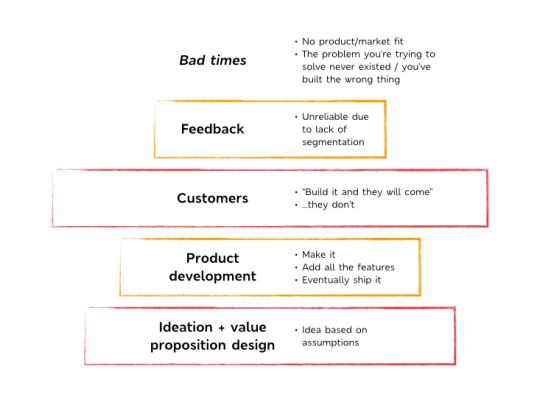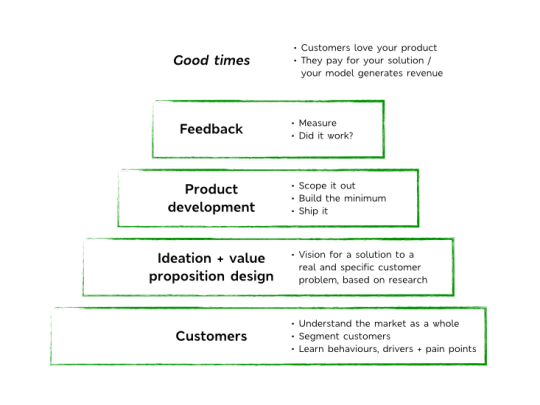Having spent time with product teams in both early-stage startups and corporate environments, I’ve observed that it’s still really easy to forget the basics when building and launching a product.
A common and simple mistake that crops up is to get carried away building something without speaking to customers first. While cracking on with building your product might feel like a natural next step, doing so can lead down a meandering and exhausting path.
I’ve previously written a couple of posts about product development and management, and how to avoid building the wrong thing for your customers. However, I wanted to better articulate the basics that are worth remembering when bringing an idea to life.
These basics are surprisingly easy to forget and are outlined here in a customer-centric hierarchy of needs, along with an example of a common not-so-customer-centric approach.
Let’s start with how not to build a product…
A not-so-customer-centric approach

From bottom to top, we begin with ideation + value proposition design. Starting with an idea isn’t a bad thing, as long as the next step is speaking to customers. But often this isn’t the case and instead the next step is to go directly to building something.
Product development – there’s a high probability that the idea is a solution to an invented problem and you’ll be wasting a lot of cash and effort by building it instead of speaking to customers first.
There’s also a tendency at this point to build as many features as possible under the ethos of “build it and they will come”. These features are again likely to be based on assumptions rather than customer development.
Customers – once you ship, it’s likely that customers don’t resonate with your product. This could be for any number of reasons…
Feedback – it’s better late than never to finally learn something from your customers!
The result – traditionally, this is the point at which you discover your product is either a solution to a problem that customer’s don’t actually have, or the wrong solution to a problem that luckily does exist.
The customer-centric approach

As an alternative, at the base of the hierarchy should be customers. Start by understanding the market you’re in, and the different types of customers in that market. For example, who are the high spenders, the low spenders, the high-frequency customers and the low-frequency ones?
It’s important to know the drivers and behaviours of each of those types of customer too. In doing so you’ll find out the pain points for each customer type and start to discover opportunities for improvements or disruption.
Ideation + value proposition design – equipped with learning about customers, the next requirement is your idea. You should be able to scope out opportunities for making customers’ lives easier with some sort of valuable product or service. A great resource for learning how to do this is the book “Value Proposition Design” by Alexander Osterwalder et al.
Product development – with a vision for a solution to an actual customer problem, you can make a start on bringing it to life. Remember to treat that vision for a solution as an assumption, and only build the minimum you need to prove or disprove that assumption.
At this point what you shouldn’t do is build absolutely every feature imaginable as there’s a fairly solid chance your customers won’t actually need them.
Feedback – with a product to put in front of customers you can see if your solution solves their problem and whether it resonates with them.
From testing on a small scale to testing with the entire market, qualitative and quantitative feedback will help you establish if you have achieved product/market fit.
The result – all being well, your customers will love your product and your idea generates revenue, either from customers paying for it or from some underlying revenue-generating model (if that applies).
While this may sound like common sense, it’s surprising how often this approach isn’t taken and it’s an easy mistake to think that once you have an idea the next step is to go and build it.
How to tell if you’re on the wrong path
If you can relate to any of the following then there’s a chance you haven’t done the correct ground work:
- You can’t describe the market you’re in
- You can’t describe the behaviour of customers within that market
- You can’t describe pain points and problems that customers experience
- You can’t justify why your product exists
- You can’t justify why a specific feature exists
While this hierarchy is a simplified whistle-stop tour of the basics, hopefully it will help you as a founder or a product manager to build the right thing for your customers.
Some resources that I and my team at M&S Venture Labs find invaluable on our product development journeys are Business Model Generation, Value Proposition Design, Lean Startup and The Startup Owner’s Manual.
If you have other examples or points I’d love to hear them. You can leave a comment below or grab me on Twitter.







Comments 4